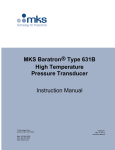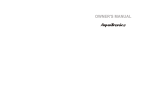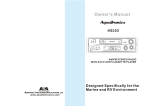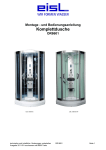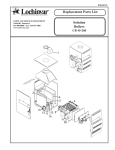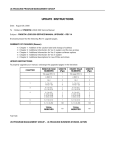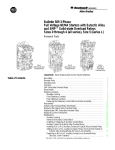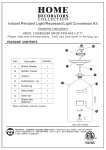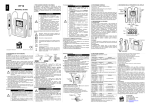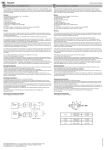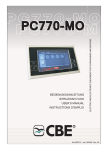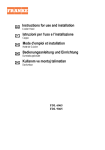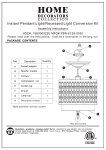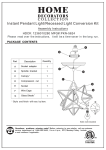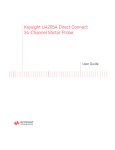Download 260PS-3B Power Supply Manual
Transcript
108196-P1 Rev C, 11/99 Instruction Manual MKS Type 260 PS-3B Power Supply Six Shattuck Road Andover, MA 01810-2449 (800) 227-8766 or (978) 975-2350 Fax: (978) 975-0093 E-mail:[email protected] Web site: http://www.mksinst.com W ARRANTY Type 260 PS-3B Equipment M KS Instrum ents, Inc. (M KS) warrants that the equipm ent described above (the “equipment”) manufactured by M KS shall be free from defects in m aterials and workm anship for a period of one year from date of shipm ent and, when installed and used in accordance with its specifications, will correctly perform all date-related operations, including without lim itation accepting data entry, sequencing, sorting, com paring, and reporting, regardless of the date the operation is perform ed or the date involved in the operation, provided that, if the equipm ent exchanges data or is otherwise used with equipm ent, software, or other products of others, such products of others them selves correctly perform all date-related operations and such products store and transm it dates and date-related data in a form at com patible with M KS equipm ent. THIS W ARRANTY IS M KS’ SOLE W ARRANTY CONCERNING DATE-RELATED OPERATIONS. For the period com m encing with the date of shipm ent of this equipm ent and ending one year later in the case of defects in m aterials and workm anship, but two years later in the case of failure to com ply with the date-related operations warranty, M KS will, at its option, either repair or replace any part which is defective in m aterials or workm anship or with respect to the date-related operations warranty without charge to the purchaser. The foregoing shall constitute the exclusive and sole rem edy of the purchaser for any breach by M KS of this warranty. The purchaser, before returning any equipm ent covered by this warranty, which is asserted to be defective by the purchaser, shall m ake specific written arrangem ents with respect to the responsibility for shipping the equipm ent and handling any other incidental charges with the M KS sales representative or distributor from which the equipm ent was purchased or, in the case of a direct purchase from M KS, with the M KS hom e office in Andover, M assachusetts, USA. This warranty does not apply to any equipm ent which has not been used in accordance with the specifications recom m ended by M KS for the proper and norm al use of the equipm ent. M KS shall not be liable under any circum stances for indirect, special, consequential, or incidental dam ages in connection with, or arising out of, the sale, perform ance, or use of the equipm ent covered by this warranty. M KS recom m ends that all M KS pressure and flow products be calibrated periodically (typically every 6 to 12 m onths) to ensure accurate readings. W hen a product is returned to M KS for this periodic re-calibration it is considered norm al preventative m aintenance not covered by any warranty. THIS W ARRANTY IS IN LIEU OF ALL OTHER RELEVANT W ARRANTIES, EXPRESSED OR IMPLIED, INCLUDING THE IMPLIED W ARRANTY OF MERCHANTABILITY AND THE IMPLIED W ARRANTY OF FITNESS FOR A PARTICULAR PURPOSE, AND ANY W ARRANTY AGAINST INFRINGEMENT OF ANY PATENT. 11-99 108196-P1 108196-P1 Rev C, 11/99 Instruction Manual MKS Type 260 PS-3B Power Supply Copyright © 1999 by MKS Instruments, Inc All rights reserved. No part of this work may be reproduced or transmitted in any form or by any means, electronic or mechanical, including photocopying and recording, or by any information storage or retrieval system, except as may be expressly permitted in writing by MKS Instruments, Inc. Printed in the United States of America Baratron® is a registered trademark of MKS Instruments, Inc., Andover, MA 2 Table Of Contents Table of Contents Table of Contents ........................................................................................................................ i Chapter One: Safety Information .................................................................................................1 Symbols Used in This Instruction Manual.......................................................................1 Symbols Found on the Unit ............................................................................................2 Safety Procedures and Precautions ..................................................................................3 Sicherheitshinweise für den Druckmeßumformer ............................................................5 In dieser Betriebsanleitung vorkommende Symbole............................................5 Erklärung der am Gerät angebrachten Symbole ..................................................6 Sicherheitsvorschriften und Vorsichtsmaßnahmen ..............................................7 Informations relatives à la sécurité ..................................................................................9 Symboles utilisés dans ce manuel d'utilisation....................................................9 Symboles apparaissant sur l'unité .....................................................................10 Mesures de sécurité et précautions....................................................................11 Medidas de seguridad ...................................................................................................13 Símbolos usados en este manual de instrucciones .............................................13 Símbolos hallados en la unidad ........................................................................14 Procedimientos y precauciones .........................................................................15 Chapter Two: Introduction ........................................................................................................17 How To Unpack the Type 260 PS-3B Unit ...................................................................17 Unpacking Checklist ........................................................................................17 Chapter Three: Installation ........................................................................................................19 Connectors .......................................................................................................19 Chapter Four: Operation............................................................................................................21 Customer Support .........................................................................................................21 Chapter Five: Specifications......................................................................................................23 Mechanical Specifications ................................................................................23 Environmental Specifications ...........................................................................23 Electrical Specifications ...................................................................................23 Chapter One: Safety Information Symbols Used in This Instruction Manual Chapter One: Safety Information Symbols Used in This Instruction Manual Definitions of WARNING, CAUTION, and NOTE messages used throughout the manual. Warning The WARNING sign denotes a hazard to personnel. It calls attention to a procedure, practice, condition, or the like, which, if not correctly performed or adhered to, could result in injury to personnel. Caution The CAUTION sign denotes a hazard to equipment. It calls attention to an operating procedure, practice, or the like, which, if not correctly performed or adhered to, could result in damage to or destruction of all or part of the product. Note The NOTE sign denotes important information. It calls attention to a procedure, practice, condition, or the like, which is essential to highlight. 1 Symbols Found on the Unit Chapter One: Safety Information Symbols Found on the Unit The following table describes symbols that may be found on the unit. Definition of Symbols Found on the Unit | Earth (ground) IEC 417, No.5017 Protective earth (ground) IEC 417, No.5019 Equipotentiality IEC 417, No.5021 Direct current IEC 417, No.5031 Alternating current IEC 417, No.5032 Both direct and alternating current IEC 417, No.5033-a Class ll equipment IEC 417, No.5172-a Three phase alternating current IEC 617-2 No.020206 Caution, refer to accompanying documents ISO 3864, No.B.3.1 Caution, risk of electric shock ISO 3864, No.B.3.6 Caution, hot surface IEC 417, No.5041 On (Supply) IEC 417, No.5007 Frame or chassis IEC 417, No.5020 Off (Supply) IEC 417, No.5008 Table 1: Definition of Symbols Found on the Unit 2 Chapter One: Safety Information Safety Procedures and Precautions Safety Procedures and Precautions Observe the following general safety precautions during all phases of operation of this instrument. Failure to comply with these precautions or with specific warnings elsewhere in this manual violates safety standards of intended use of the instrument and may impair the protection provided by the equipment. MKS Instruments, Inc. assumes no liability for the customer’s failure to comply with these requirements. DO NOT SUBSTITUTE PARTS OR MODIFY INSTRUMENT Do not install substitute parts or perform any unauthorized modification to the instrument. Return the instrument to an MKS Calibration and Service Center for service and repair to ensure that all safety features are maintained. SERVICE BY QUALIFIED PERSONNEL ONLY Operating personnel must not attempt component replacement and internal adjustments. Any service must be made by qualified service personnel only. USE CAUTION WHEN OPERATING WITH HAZARDOUS MATERIALS If hazardous materials are used, users must take responsibility to observe the proper safety precautions, completely purge the instrument when necessary, and ensure that the material used is compatible with the materials in this product, including any sealing materials. PURGE THE INSTRUMENT After installing the unit, or before removing it from a system, purge the unit completely with a clean, dry gas to eliminate all traces of the previously used flow material. USE PROPER PROCEDURES WHEN PURGING This instrument must be purged under a ventilation hood, and gloves must be worn for protection. DO NOT OPERATE IN AN EXPLOSIVE ENVIRONMENT To avoid explosion, do not operate this product in an explosive environment unless it has been specifically certified for such operation. USE PROPER FITTINGS AND TIGHTENING PROCEDURES All instrument fittings must be consistent with instrument specifications, and compatible with the intended use of the instrument. Assemble and tighten fittings according to manufacturer’s directions. 3 Safety Procedures and Precautions Chapter One: Safety Information CHECK FOR LEAK-TIGHT FITTINGS Carefully check all vacuum component connections to ensure leak-tight installation. OPERATE AT SAFE INLET PRESSURES Never operate at pressures higher than the rated maximum pressure (refer to the product specifications for the maximum allowable pressure). INSTALL A SUITABLE BURST DISC When operating from a pressurized gas source, install a suitable burst disc in the vacuum system to prevent system explosion should the system pressure rise. KEEP THE UNIT FREE OF CONTAMINANTS Do not allow contaminants to enter the unit before or during use. Contamination such as dust, dirt, lint, glass chips, and metal chips may permanently damage the unit or contaminate the process. ALLOW PROPER WARM UP TIME FOR TEMPERATURE-CONTROLLED UNITS Temperature-controlled units will only meet specifications when sufficient time is allowed for the unit to meet, and stabilize at, the designed operating temperature. Do not zero or calibrate the unit until the warm up is complete. 4 Chapter One: Safety Information Sicherheitshinweise für den Druckmeßumformer Sicherheitshinweise für den Druckmeßumformer In dieser Betriebsanleitung vorkommende Symbole Bedeutung der mit WARNUNG!, VORSICHT! und HINWEIS gekennzeichneten Absätze in dieser Betriebsanleitung. Warnung! Das Symbol WARNUNG! weist auf eine Gefahr für das Bedienpersonal hin. Es macht auf einen Arbeitsablauf, eine Arbeitsweise, einen Zustand oder eine sonstige Gegebenheit aufmerksam, deren unsachgemäße Ausführung bzw. ungenügende Berücksichtigung zu Verletzungen führen kann. Vorsicht! Das Symbol VORSICHT! weist auf eine Gefahr für das Gerät hin. Es macht auf einen Bedienungsablauf, eine Arbeitsweise oder eine sonstige Gegebenheit aufmerksam, deren unsachgemäße Ausführung bzw. ungenügende Berücksichtigung zu einer Beschädigung oder Zerstörung des Gerätes oder von Teilen des Gerätes führen kann. Hinweis Das Symbol HINWEIS macht auf wichtige Informationen bezüglich eines Arbeitsablaufs, einer Arbeitsweise, eines Zustands oder einer sonstige Gegebenheit aufmerksam. 5 Sicherheitshinweise für den Druckmeßumformer Chapter One: Safety Information Erklärung der am Gerät angebrachten Symbole Nachstehender Tabelle sind die Bedeutungen der Symbole zu entnehmen, die am Gerät angebracht sein können. Bedeutung der am Gerät angebrachten Symbole | Ein (Energie) IEC 417, No.5007 Aus (Energie) IEC 417, No.5008 Erdanschluß IEC 417, No.5017 Schutzleiteranschluß IEC 417, No.5019 Masseanschluß IEC 417, No.5020 Aquipotentialanschluß IEC 417, No.5021 Gleichstrom IEC 417, No.5031 Wechselstrom IEC 417, No.5032 Gleich- oder Wechselstrom IEC 417, No.5033-a Durchgängige doppelte oder verstärkte Isolierung IEC 417, No.5172-a IEC 617-2, No.020206 Warnung vor einer Gefahrenstelle (Achtung, Dokumentation beachten) ISO 3864, No.B.3.1 Warnung vor gefährlicher elektrischer Spannung ISO 3864, No.B.3.6 Höhere Temperatur an leicht zugänglichen Teilen IEC 417, No.5041 DreileiterWechselstrom (Drehstrom) Tabelle 2: Bedeutung der am Gerät angebrachten Symbole 6 Chapter One: Safety Information Sicherheitshinweise für den Druckmeßumformer Sicherheitsvorschriften und Vorsichtsmaßnahmen Folgende allgemeine Sicherheitsvorschriften sind während allen Betriebsphasen dieses Gerätes zu befolgen. Eine Mißachtung der Sicherheitsvorschriften und sonstiger Warnhinweise in dieser Betriebsanleitung verletzt die für dieses Gerät und seine Bedienung geltenden Sicherheitsstandards, und kann die Schutzvorrichtungen an diesem Gerät wirkungslos machen. MKS Instruments, Inc. haftet nicht für Mißachtung dieser Sicherheitsvorschriften seitens des Kunden. Niemals Teile austauschen oder Änderungen am Gerät vornehmen! Ersetzen Sie keine Teile mit baugleichen oder ähnlichen Teilen, und nehmen Sie keine eigenmächtigen Änderungen am Gerät vor. Schicken Sie das Gerät zwecks Wartung und Reparatur an den MKS-Kalibrierungs- und -Kundendienst ein. Nur so wird sichergestellt, daß alle Schutzvorrichtungen voll funktionsfähig bleiben. Wartung nur durch qualifizierte Fachleute! Das Auswechseln von Komponenten und das Vornehmen von internen Einstellungen darf nur von qualifizierten Fachleuten durchgeführt werden, niemals vom Bedienpersonal. Vorsicht beim Arbeiten mit gefährlichen Stoffen! Wenn gefährliche Stoffe verwendet werden, muß der Bediener die entsprechenden Sicherheitsvorschriften genauestens einhalten, das Gerät, falls erforderlich, vollständig spülen, sowie sicherstellen, daß der Gefahrstoff die am Gerät verwendeten Materialien, insbesondere Dichtungen, nicht angreift. Spülen des Gerätes mit Gas! Nach dem Installieren oder vor dem Ausbau aus einem System muß das Gerät unter Einsatz eines reinen Trockengases vollständig gespült werden, um alle Rückstände des Vorgängermediums zu entfernen. Anweisungen zum Spülen des Gerätes Das Gerät darf nur unter einer Ablufthaube gespült werden. Schutzhandschuhe sind zu tragen. Gerät nicht zusammen mit explosiven Stoffen, Gasen oder Dämpfen benutzen! Um der Gefahr einer Explosion vorzubeugen, darf dieses Gerät niemals zusammen mit (oder in der Nähe von) explosiven Stoffen aller Art eingesetzt werden, sofern es nicht ausdrücklich für diesen Zweck zugelassen ist. 7 Sicherheitshinweise für den Druckmeßumformer Chapter One: Safety Information Anweisungen zum Installieren der Armaturen! Alle Anschlußstücke und Armaturenteile müssen mit der Gerätespezifikation übereinstimmen, und mit dem geplanten Einsatz des Gerätes kompatibel sein. Der Einbau, insbesondere das Anziehen und Abdichten, muß gemäß den Anweisungen des Herstellers vorgenommen werden. Verbindungen auf Undichtigkeiten prüfen! Überprüfen Sie sorgfältig alle Verbindungen der Vakuumkomponenten auf undichte Stellen. Gerät nur unter zulässigen Anschlußdrücken betreiben! Betreiben Sie das Gerät niemals unter Drücken, die den maximal zulässigen Druck (siehe Produktspezifikationen) übersteigen. Geeignete Berstscheibe installieren! Wenn mit einer unter Druck stehenden Gasquelle gearbeitet wird, sollte eine geeignete Berstscheibe in das Vakuumsystem installiert werden, um eine Explosionsgefahr aufgrund von steigendem Systemdruck zu vermeiden. Verunreinigungen im Gerät vermeiden! Stellen Sie sicher, daß Verunreinigungen jeglicher Art weder vor dem Einsatz noch während des Betriebs in das Instrumenteninnere gelangen können. Staub- und Schmutzpartikel, Glassplitter oder Metallspäne können das Gerät dauerhaft beschädigen oder Prozeß und Meßwerte verfälschen. Bei Geräten mit Temperaturkontrolle korrekte Anwärmzeit einhalten! Temperaturkontrollierte Geräte arbeiten nur dann gemäß ihrer Spezifikation, wenn genügend Zeit zum Erreichen und Stabilisieren der Betriebstemperatur eingeräumt wird. Kalibrierungen und Nulleinstellungen sollten daher nur nach Abschluß des Anwärmvorgangs durchgeführt werden. 8 Chapter One: Safety Information Informations relatives à la sécurité Informations relatives à la sécurité Symboles utilisés dans ce manuel d'utilisation Définitions des indications AVERTISSEMENT, ATTENTION, et REMARQUE utilisées dans ce manuel. Avertissement Attention Remarque L'indication AVERTISSEMENT signale un danger pour le personnel. Elle attire l'attention sur une procédure, une pratique, une condition, ou toute autre situation présentant un risque d'accident pour le personnel, en cas d'exécution incorrecte ou de non respect des consignes. L'indication ATTENTION signale un danger pour l'appareil. Elle attire l'attention sur une procédure d'exploitation, une pratique, ou toute autre situation, présentant un risque d'endommagement ou de destruction d'une partie ou de la totalité de l'appareil, en cas d'exécution incorrecte ou de non respect des consignes. L'indication REMARQUE signale une information importante. Elle attire l'attention sur une procédure, une pratique, une condition, ou toute autre situation, présentant un intérêt particulier. 9 Informations relatives à la sécurité Chapter One: Safety Information Symboles apparaissant sur l'unité Le tableau suivant décrit les symboles pouvant apparaître sur l'unité. Définition des symboles apparaissant sur l'unité | Marche (sous tension) IEC 417, No.5007 Arrêt (hors tension) IEC 417, No.5008 Terre (masse) IEC 417, No.5017 Terre de protection (masse) IEC 417, No.5019 Masse IEC 417, No.5020 Equipotentialité IEC 417, No.5021 Courant continu IEC 417, No.5031 Courant alternatif IEC 417, No.5032 Courant continu et alternatif IEC 417, No.5033-a Matériel de classe II IEC 417, No.5172-a Courant alternatif triphasé IEC 617-2, No.020206 Attention : se reporter à la documentation ISO 3864, No.B.3.1 Attention : risque de choc électrique ISO 3864, No.B.3.6 Attention : surface brûlante IEC 417, No.5041 Tableau 3: Définition des symboles apparaissant sur l'unité 10 Chapter One: Safety Information Informations relatives à la sécurité Mesures de sécurité et précautions Prendre les précautions générales de sécurité suivantes pendant toutes les phases d'exploitation de cet appareil. Le non respect des ces précautions ou des avertissements contenus dans ce manuel constitue une violation des normes de sécurité relatives à l'utilisation de l'appareil et peut diminuer la protection fournie par l'appareil. MKS Instruments, Inc. n'assume aucune responsabilité concernant le non respect des consignes par les clients. PAS DE SUBSTITUTION DE PIÈCES OU DE MODIFICATION DE L'APPAREIL Ne pas installer des pièces de substitution ou effectuer des modifications non autorisées sur l'appareil. Renvoyer l'appareil à un centre de service et de calibrage MKS pour tout dépannage ou réparation afin de garantir le l'intégrité des dispositifs de sécurité. DÉPANNAGE UNIQUEMENT PAR DU PERSONNEL QUALIFIÉ Le personnel d'exploitation ne doit pas essayer de remplacer des composants ou de faire des réglages internes. Tout dépannage doit être uniquement effectué par du personnel qualifié. PRÉCAUTION EN CAS D'UTILISATION AVEC DES PRODUITS DANGEREUX Si des produits dangereux sont utilisés, l'utilisateur est responsable de la prise des mesures de précaution appropriées, de la purge complète de l'appareil quand cela est nécessaire, et de la garantie que les produits utilisés sont compatibles avec les composants de cet appareil, y compris les matériaux d'étanchéité. PURGE DE L'APPAREIL Après l'installation de l'unité, ou avant son enlèvement d'un système, purger l'unité complètement avec un gaz propre et sec afin d'éliminer toute trace du produit de flux utilisé précédemment. UTILISATION DES PROCÉDURES APPROPRIÉES POUR LA PURGE Cet appareil doit être purgé sous une hotte de ventilation, et il faut porter des gants de protection. PAS D'EXPLOITATION DANS UN ENVIRONNEMENT EXPLOSIF Pour éviter toute explosion, ne pas utiliser cet appareil dans un environnement explosif, sauf en cas d'homologation spécifique pour une telle exploitation. UTILISATION D'ÉQUIPEMENTS APPROPRIÉS ET PROCÉDURES DE SERRAGE Tous les équipements de l'appareil doivent être cohérents avec ses spécifications, et compatibles avec l'utilisation prévue de l'appareil. Assembler et serrer les équipements conformément aux directives du fabricant. VÉRIFICATION DE L'ÉTANCHÉITÉ DES CONNEXIONS Vérifier attentivement toutes les connexions des composants pour le vide afin de garantir l'étanchéité de l'installation. 11 Informations relatives à la sécurité Chapter One: Safety Information EXPLOITATION AVEC DES PRESSIONS D'ENTRÉE NON DANGEREUSES Ne jamais utiliser des pressions supérieures à la pression nominale maximum (se reporter aux spécifications de l'unité pour la pression maximum admissible). INSTALLATION D'UN DISQUE D'ÉCHAPPEMENT ADAPTÉ En cas d'exploitation avec une source de gaz pressurisé, installer un disque d'échappement adapté dans le système à vide, afin d'éviter une explosion du système en cas d'augmentation de la pression. MAINTIEN DE L'UNITÉ À L'ABRI DES CONTAMINATIONS Ne pas laisser des produits contaminants pénétrer dans l'unité avant ou pendant l'utilisation. Des produits contaminants tels que des poussières et des fragments de tissu, de glace et de métal peuvent endommager l'unité d'une manière permanente ou contaminer le processus. RESPECT DU TEMPS D'ÉCHAUFFEMENT APPROPRIÉ POUR LES UNITÉS Á TEMPÉRATURE CONTRÔLÉE Les unités à température contrôlée atteignent leurs spécifications uniquement quand on leur laisse un temps suffisant pour atteindre d'une manière stable la température d'exploitation. Ne pas remettre à zéro ou calibrer l'unité tant que l'échauffement n'est pas terminé. 12 Chapter One: Safety Information Medidas de seguridad Medidas de seguridad Símbolos usados en este manual de instrucciones Definiciones de los mensajes de advertencia, precaución y de las notas usados en el manual. Advertencia El símbolo de advertencia indica la posibilidad de que se produzcan daños personales. Pone de relieve un procedimiento, práctica, estado, etc. que en caso de no realizarse u observarse correctamente puede causar daños personales. Precaución El símbolo de precaución indica la posibilidad de producir daños al equipo. Pone de relieve un procedimiento operativo, práctica, estado, etc. que en caso de no realizarse u observarse correctamente puede causar daños o la destrucción total o parcial del equipo. Nota El símbolo de notas indica información de importancia. Este símbolo pone de relieve un procedimiento, práctica o condición cuyo conocimiento es esencial destacar. 13 Medidas de seguridad Chapter One: Safety Information Símbolos hallados en la unidad La tabla siguiente contiene los símbolos que puede hallar en la unidad. Definición de los símbolos hallados en la unidad | Encendido (alimentación eléctrica) IEC 417, N° 5007 Apagado (alimentación eléctrica) IEC 417, N° 5008 Puesta a tierra IEC 417, N° 5017 Protección a tierra IEC 417, N° 5019 Caja o chasis IEC 417, N° 5020 Equipotencialidad IEC 417, N° 5021 Corriente continua IEC 417, N° 5031 Corriente alterna IEC 417, N° 5032 Corriente continua y alterna IEC 417, N° 5033-a Equipo de clase II IEC 417, N° 5172-a Corriente alterna trifásica IEC 617-2, N° 020206 Precaución. Consulte los documentos adjuntos ISO 3864, N° B.3.1 Precaución. Riesgo de descarga eléctrica ISO 3864, N° B.3.6 Precaución. Superficie caliente IEC 417, N° 5041 Tabla 4: Definición de los símbolos hallados en la unidad 14 Chapter One: Safety Information Medidas de seguridad Procedimientos y precauciones Las precauciones generales de seguridad descritas a continuación deben observarse durante todas las etapas de funcionamiento del instrumento. La falta de cumplimiento de dichas precauciones o de las advertencias específicas a las que se hace referencia en el manual, constituye una violación de las normas de seguridad establecidas para el uso previsto del instrumento y podría anular la protección proporcionada por el equipo. Si el cliente no cumple dichas precauciones y advertencias, MKS Instruments, Inc. no asume responsabilidad legal alguna. NO UTILICE PIEZAS NO ORIGINALES O MODIFIQUE EL INSTRUMENTO No instale piezas que no sean originales ni modifique el instrumento sin autorización. Para asegurar el correcto funcionamiento de todos los dispositivos de seguridad, envíe el instrumento al Centro de servicio y calibración de MKS toda vez que sea necesario repararlo o efectuar tareas de mantenimiento. LAS REPARACIONES DEBEN SER EFECTUADAS ÚNICAMENTE POR TÉCNICOS AUTORIZADOS Los operarios no deben intentar reemplazar los componentes o realizar tareas de ajuste en el interior del instrumento. Las tareas de mantenimiento o reparación deben ser realizadas únicamente por personal autorizado. TENGA CUIDADO CUANDO TRABAJE CON MATERIALES TÓXICOS Cuando se utilicen materiales tóxicos, es responsabilidad de los operarios tomar las medidas de seguridad correspondientes, purgar totalmente el instrumento cuando sea necesario y comprobar que el material utilizado sea compatible con los materiales del instrumento e inclusive, con todos los materiales de sellado. PURGUE EL INSTRUMENTO Una vez instalada la unidad o antes de retirarla del sistema, purgue completamente la unidad con gas limpio y seco para eliminar todo resto de la sustancia líquida empleada anteriormente. USE PROCEDIMIENTOS ADECUADOS PARA REALIZAR LA PURGA El instrumento debe purgarse debajo de una campana de ventilación y deben utilizarse guantes protectores. NO HAGA FUNCIONAR EL INSTRUMENTO EN AMBIENTES CON RIESGO DE EXPLOSIÓN Para evitar que se produzcan explosiones, no haga funcionar este instrumento en un ambiente con riesgo de explosiones, excepto cuando el mismo haya sido certificado específicamente para tal uso. 15 Medidas de seguridad Chapter One: Safety Information USE ACCESORIOS ADECUADOS Y REALICE CORRECTAMENTE LOS PROCEDIMIENTOS DE AJUSTE Todos los accesorios del instrumento deben cumplir las especificaciones del mismo y ser compatibles con el uso que se debe dar al instrumento. Arme y ajuste los accesorios de acuerdo con las instrucciones del fabricante. COMPRUEBE QUE LAS CONEXIONES SEAN A PRUEBA DE FUGAS Inspeccione cuidadosamente las conexiones de los componentes de vacío para comprobar que hayan sido instalados a prueba de fugas. HAGA FUNCIONAR EL INSTRUMENTO CON PRESIONES DE ENTRADA SEGURAS No haga funcionar nunca el instrumento con presiones superiores a la máxima presión nominal (en las especificaciones del instrumento hallará la presión máxima permitida). INSTALE UNA CÁPSULA DE SEGURIDAD ADECUADA Cuando el instrumento funcione con una fuente de gas presurizado, instale una cápsula de seguridad adecuada en el sistema de vacío para evitar que se produzcan explosiones cuando suba la presión del sistema. MANTENGA LA UNIDAD LIBRE DE CONTAMINANTES No permita el ingreso de contaminantes en la unidad antes o durante su uso. Los productos contaminantes tales como polvo, suciedad, pelusa, lascas de vidrio o virutas de metal pueden dañar irreparablemente la unidad o contaminar el proceso. CALIENTE ADECUADAMENTE LAS UNIDADES CONTROLADAS POR MEDIO DE TEMPERATURA Las unidades controladas por medio de temperatura funcionarán de acuerdo con las especificaciones sólo cuando se las caliente durante el tiempo suficiente para permitir que lleguen y se estabilicen a la temperatura de operación indicada. No calibre la unidad y no la ponga en cero hasta que finalice el procedimiento de calentamiento. 16 Chapter Two Introduction Chapter Two: Introduction This documents the features of the Type 260 PS-3B power supply. How To Unpack the Type 260 PS-3B Unit MKS has carefully packed the Type 260 PS-3B unit so that it will reach you in perfect operating order. Upon receiving the unit, however, you should check for defects, cracks, broken connectors, etc., to be certain that damage has not occurred during shipment. Note Do not discard any packing materials until you have completed your inspection and are sure the unit arrived safely. If you find any damage, notify your carrier and MKS immediately. If it is necessary to return the unit to MKS, obtain an ERA Number (Equipment Return Authorization Number) from the MKS Service Center before shipping. Please refer to the last page of this supplement for a list of MKS Calibration and Service Centers. Caution Only qualified individuals should perform the installation and any user adjustments. They must comply with all the necessary ESD and handling precautions while installing and adjusting the instrument. Proper handling is essential when working with all highly sensitive precision electronic instruments. Unpacking Checklist Standard Equipment: • Type 260 PS-3B Unit • Type 260 PS-3B Supplement (this document) Optional Equipment: • CB260-1-xx cable (where xx indicates the length) to connect the 260 PS-3B to a load 17 Chapter Two Introduction This page intentionally left blank 18 Chapter Three Installation Chapter Three: Installation Caution The 260 PS-3B power supply requires adequate air circulation to operate under full load conditions. Locate the 260 PS-3B unit so that air flows above and behind the unit. Connectors The 260 PS-3B unit has two 5-pin female Amphenol connectors on the rear panel. The mating male connector is available from MKS (part number 112-3506) or Amphenol (part number 126217). Note The “Reserved” pin assignment refers to a pin that may be assigned a function in the future. Connector J1 Pinout Pin Assignment A Reserved D +15 VDC E -15 VDC B Power Ground H Chassis Table 5: Connector J1 Pinout Connector J2 Pinout Pin Assignment A Reserved D +15 VDC E -15 VDC B Power Ground H Chassis Table 6: Connector J2 Pinout 19 Chapter Three Installation This page intentionally left blank 20 Chapter Five Specifications Chapter Four: Operation 1. Connect the loads to the 260 PS-3B unit using interface cables CB260-1-xx (where xx indicates the length). 2. Turn the power switch on. The front panel lamps indicate when the power supplies are on. Customer Support Standard maintenance and repair services are available at all of our regional MKS Calibration and Service Centers, listed on the last page of this supplement. In addition, MKS accepts the instruments of other manufacturers for recalibration using the Primary and Transfer Standard calibration equipment located at all of our regional service centers. Should any difficulties arise in the use of your Type 260 PS-3B instrument, or to obtain information about companion products MKS offers, contact any authorized MKS Calibration and Service Center. If it is necessary to return the instrument to MKS, please obtain an ERA Number (Equipment Return Authorization Number) from the MKS Calibration and Service Center before shipping. The ERA Number expedites handling and ensures proper servicing of your instrument. Please refer to the last page of this supplement for a list of MKS Calibration and Service Centers. Warning All returns to MKS Instruments must be free of harmful, corrosive, radioactive, or toxic materials. 21 Chapter Four Operation This page intentionally left blank 22 Chapter Five Specifications Chapter Five: Specifications Mechanical Specifications Package Cabinet style or rack mount Weight 5 lbs. (2.3 kg) Environmental Specifications Maximum Operating Temperature 50° C (122° F) Electrical Specifications Power Consumption 175 Watts @ 120V, 60 Hz Input Voltage 85/264 VAC 47-440 Hz Output Voltage ±15 Volts @ 3.4 A Output Noise and Ripple ≤ 150 mV P/P Short Circuit Protection Standard Temperature Coefficient ±0.04% / °C 23





























